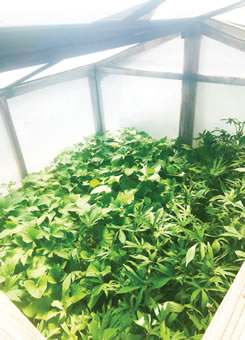The Jeavons Center Mini-Farm Report We've had another year of exceptional drought in California, but summer is over, and the first frosts are touching the mountains above Willits this week. Like farmers all over the northern hemisphere, The Jeavons Center team is getting ready for the cold and (hopefully!) rainy season in the GROW BIOINTENSIVE mini farm. If you’re looking for inspiration, or just want to know what we’re doing, here are some of the crops we have already planted, and will be planting through the winter into 2023, and why. Already planted Wheat - We prefer the Hard Red Spring variety of wheat to the Hard Red Winter type as it thrives at our site much better. Currently planting Fava Beans - Banner cold weather fava beans, interplanted with Woolly Pod vetch. We like the Banner variety as the plants are robust and can grow well down to 10 degrees Fahrenheit. Banner also produces more biomass than the Frederick, and Veroma fava bean varieties. Wooly Pod vetch has the capacity to fix up to 0.63 pounds of nitrogen per 100 sq ft compared with other temperate legumes that fix 0.21 lbs in the same area, so less seed is needed to accomplish building up and holding nitrogen in the soil with Woolly Pod. Banner seeds are difficult to locate, so some beds are devoted entirely to this mix, growing to seed so we have a supply for future seasons; but we also plant it around our perennials during the cool/cold/rainy season as well. The advantage to interplanting legumes with other crops and then harvesting the legumes when they first go to flower (instead of waiting for them to go to seed) is that the nitrogen fixed in the root nodules can remain in the soil to grow whichever crop you choose to plant in the next season, rather than going into producing legume seed. This means that, instead of using valuable bed/ crop/months to grow a nitrogen-fixing crop to fix nitrogen in the soil for a third season after you grow a grain, seed or other nitrogen-intensive crop, you can grow the nitrogen, in many cases at the same time as the primary crop, and leave extra bed/crop/months–and nitrogen!— for the growing of calorie and carbon crops. Planning to plant 10-Bed Unit Complete Balanced Diet Crops - in the main mid-May through mid-October growing season at TJC. Three different 10-Bed Unit diet designs will be grown at TJC by our Farmer/Teacher/Trainer team in 2023. The crops noted below are historically and climatically especially important for these designs:
We grow sweet potatoes using miniature greenhouses (see plans in How to Grow More Vegetables) for the added heat needed in our northern temperate climate, and with the crop protected with gopher cages (for a description and pictures on how to make a simple, fairly long-lasting gopher cage for a GB growing bed, see growbiointensive.org/news-0705.htm).
Sorghum – We prefer the Dale variety. We find it performs better at our latitude. Potatoes – 65-Day maturing Yukon Gold variety, which provide more nutrition in less time than 90- or 120-day maturing varieties, again leaving more bed/crop/months for growing additional crops. Selecting and trialing varieties that have the potential to grow good yields in a short time is an important part of creating a successful garden plan for growing a complete, balanced diet in a smaller area – the primary focus of our international 10-Bed Unit Project.
Corn – Oaxacan Green variety does best for us given our relatively cool night climate. This 95-day maturing variety is “dent corn” used to make cornmeal, and has beautiful emerald green kernels. Many Other Crops – carbon and calories aren’t enough! Additional crops provide the necessary vitamins, minerals, and essential amino acids to create a full, varied, and nutritionally balanced diet, and each 10-Bed Unit will incorporate different crops according to the taste and preference of farmer-designer. This topic is explored in Ecology Action’s Booklet 31: Designing a GROW BIOINTENSIVE® Sustainable Mini-Farm, 2022 revision. Looking ahead, Ecology Action will present our 4-Saturdays Introductory GROW BIOINTENSIVE Workshop online this spring on Feb. 25, March 4, 11, & 18, 2023. It's fun, interesting, and easy to participate in! See growbiointensive.org/ workshop.html for details and registration.I hope to see you there!
Let’s Come Together To: Grow Hope Grow Abundance Grow Biointensive! ♥ top | Newsletter Home |Table of Contents| Archive
|


 Sweet Potatoes – we are growing the rarer 3-month
maturing heirloom varieties from Sand Hill Preservation
Center available at:
Sweet Potatoes – we are growing the rarer 3-month
maturing heirloom varieties from Sand Hill Preservation
Center available at: 


